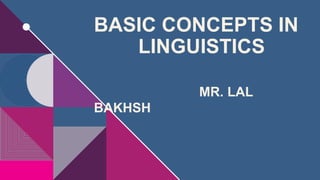
Basic concepts in linguistics including all.pptx
- 1. BASIC CONCEPTS IN LINGUISTICS MR. LAL BAKHSH
- 2. AGENDA History Langue Vs Parole Competence Vs Performance Types of various signs Signifier Vs Signified Syntagmatic Vs Paradigmatic Relationship Substance and Form Question-answer sessions 2
- 3. HISTORY
- 4. HISTORICAL BACKGROUND Modern linguistics is based on some fundamental concepts which were expounded by linguists in the beginning of the twentieth century. The most influential of these were:: (i) The representatives of the American School of structural anthropologists, chiefly Leonard Bloomfield; and after World War II, the work of Noam Chomsky. (ii) The European linguists, chiefly among them the Swiss linguist Ferdinand de Saussure. 4
- 5. CONTINUE…. 5 The main ideas regarding language propounded by these linguists take the form of certain distinctions or dichotomies by means of which we have been able to understand the nature of language in a more systematic and complete way Some of the basic distinctions, dichotomies and concepts are discussed now:
- 6. UNDERSTANDING LANGUE & PAROLE Ferdinand de Saussure 6
- 7. DEFINITIONS OF LANGUE & PAROLE Langue (i) Langue is social, a set of conventions shared by all the speakers of a language. (ii) Langue is abstract, as these conventions exist in the minds of the speakers who belong to that society that has created the language. Parole (i) Individual performance of language in speech or writing. (ii) Concrete and physical. It makes use of the physiological mechanism such as speech organs, in uttering words and sentences. 7
- 8. COMPETENCE & PERFORMANCE NOAM CHOMSKY Competence Competence: This refers to an individual's underlying knowledge of a language's rules and structures. It encompasses what a person knows about their language, including grammar, vocabulary, and syntax, often at an unconscious level. Competence is concerned with the idealized speaker- hearer's knowledge of a Performance Performance, on the other hand, pertains to the actual use or application of linguistic knowledge in real-time communication. It involves the practical application of linguistic competence in speaking, understanding, reading, or writing. Performance can be influenced by various factors such as memory limitations, distractions, or processing constraints. 8
- 9. SIGNIFIER VS SIGNIFIED 1. Signifier: This refers to the physical form of a sign, which could be a word, sound, image, gesture, or any other perceptible element. The signifier is the material or tangible aspect that we perceive with our senses. For example, the word "tree" in written or spoken form, or the image of a tree, serves as a signifier. 2. Signified: This is the conceptual or mental representation associated with a particular signifier. It is the meaning or idea conveyed by the signifier. The signified is the mental image, concept, or understanding that arises in the mind of the interpreter when encountering the signifier. Using the previous example, the concept of a tree – the mental image or idea of a tall plant with a trunk and branches – is the signified associated with the signifier "tree." 9
- 10. CONTINUE… 10
- 11. SIGN VS SYMBOL Sign: A sign is a basic unit of meaning in language or communication. It consists of two components: the signifier and the signified. The signifier is the form of the sign, which could be a word, sound, image, gesture, etc., while the signified is the concept or meaning associated with that form. Signs can be natural or conventional, and they convey meaning through the relationship between the signifier and the signified. For example, the word "cat" is a sign with the signifier being the letters c-a-t and the signified being the concept of a small, furry animal. Symbol: A symbol is a type of sign that represents something beyond its literal meaning. Unlike signs, symbols often have arbitrary or culturally specific meanings that are not directly tied to their form. Symbols acquire their meaning through social convention, cultural context, or individual interpretation. They can be words, images, gestures, or objects that stand for abstract concepts, ideas, or emotions. For instance, a red heart symbolizes love or affection, but this association is not inherently tied to the physical form of a heart. Symbols are characterized by their capacity to carry rich layers of meaning and can evoke complex associations. 11
- 12. SYNTAGMATIC VS PARADIGMATIC RELATIONSHIP 12 Paradigmatic relationship = between elements in a class or system, only one can operate at a time. Syntagmatic relationship = between elements in a linear sequence, structural
- 13. SUBSTANCE AND FORM Substance: In linguistics, substance refers to the material or concrete elements of language, such as sounds, letters, and words. It encompasses the physical manifestation of language, including the sounds produced when speaking, the written symbols used in writing, and the individual lexical items or words themselves. Substance is concerned with the actual material that comprises language, regardless of its meaning or function. Form: Form, on the other hand, refers to the abstract organization or structure of linguistic elements. It encompasses the patterns, rules, and arrangements that govern how linguistic units are combined and structured to convey meaning. Form includes grammatical rules, syntactic structures, and phonological patterns that determine how sounds, words, and sentences are organized in a language. Form is concerned with the systematic organization and arrangement of linguistic elements to create meaningful communication. 13